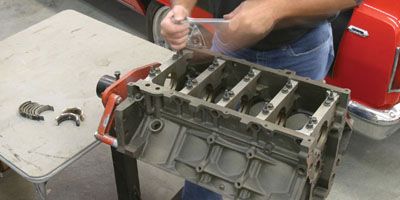
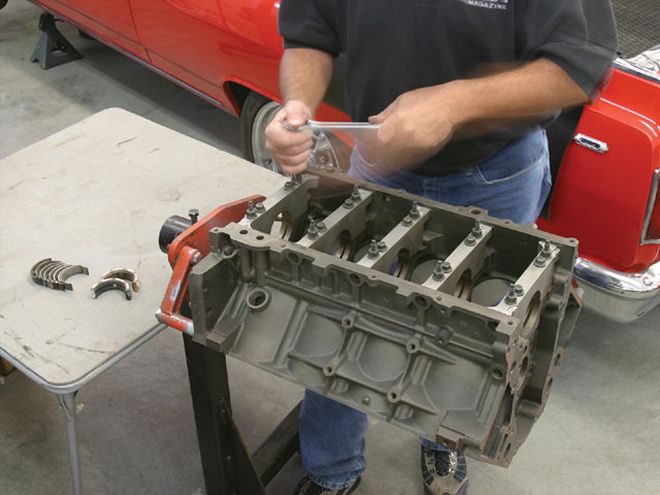 Building a reliable stroke Gen III/IV isn't difficult if you know which pitfalls to avoid. The most vexing decision will be how big to build it.
Building a reliable stroke Gen III/IV isn't difficult if you know which pitfalls to avoid. The most vexing decision will be how big to build it.
When it comes to car crafting, it's all about horsepower. The latest darling for the GM devotees of more power is the newest generation of small-block engines, more accurately termed Gen III and Gen IV. These new-millennium small-blocks are quickly becoming a favorite engine swap powerplant. For those willing to spend a little coin on building something a little more exotic, there are plenty of opportunities to expand the stock bore and stroke combinations for more displacement. If you've got deeper pockets, the LS2 and LS3 engines offer larger bores right out of the box, combined with an enticing all-aluminum structure. Or you can pony up for an iron block from GM Performance Parts, aluminum World Products Warhawk block, or a CNC billet Dart piece. Whichever way, you have the foundation for big inches.
Of course, for those of us who aren't on the board of directors of an oil company, there's also the classic route using a stroker crank in a stock production block. This is an outstanding approach that combines power with a more conservative financial investment, and it seems the aftermarket crank companies aren't shy about offering some really outrageous strokes. There are land mines you really should look out for, too, and we know where most of them are. So tag along on our stroked and bored journey through the Gen III/IV maze and see what floats your horsepower boat.
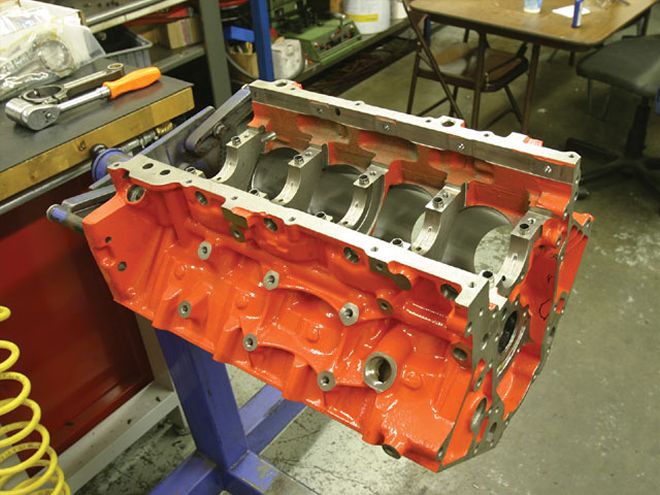 This is the GM Performance Parts LSX iron block. While heavy, it's designed to handle upwards of 2,000 hp. That should be enough for most car crafters, don't you think?
This is the GM Performance Parts LSX iron block. While heavy, it's designed to handle upwards of 2,000 hp. That should be enough for most car crafters, don't you think?
Block Basics
Power is all about breathing, especially if you are planning to build a big displacement engine. One of the main limitations on the early LS1/LS6 engines is the 3.898-inch bore and the rather thin iron liners that limit enlarging the bores more than 0.010 inch. That quest for more power and better breathing from very good production heads is what drove GM to the Gen IV LS2/LS3/L92 engines that now sport wider 4.00- or 4.060-inch bores. Not only does the larger bore improve breathing, but the greater diameter also allows larger intake valves. The now-famous L92 truck heads come right from the factory with massive 2.16/1.59-inch valves. But remember, these rotund valves will not fit in any bore smaller than 4.00 inches.
Of course, aluminum blocks are also prized for their reduced weight. A stock LS1 aluminum block barely registers at 110 pounds, while iron blocks push that figure to a more robust 175 pounds. The incentive to side with iron is increased strength, more bore size options, and a budget price. Even as thin-wall castings, all iron blocks can be bored 0.030 inch to help boost the displacement. If you want to really step up in durability, the GM Performance Parts LSX iron block is among the sturdiest, as revealed in its bare casting weight of a rugged 225 pounds or about 50 pounds heavier than a production iron block. In theory, there is enough room to stuff a 4.250-inch stroke crank in the LSX block, but this also means that with a 6.125-inch rod, the piston's compression height would only be 0.990 inch and the piston skirt would extend another 0.125 inch out of the bottom of the bore compared with a 4.00-inch stroke crank. No engine builder we talked to was comfortable with that.
If you're into really large inches, there's the World Products Warhawk aluminum block that specs in at 133 pounds with caps and iron sleeves. With a 9.240-inch deck height, it can accommodate up to a 4.00-inch stroke and a 4.155-inch bore, which will create 434 ci. If you want more, World also has a tall-deck Warhawk block with a deck of 9.800 inches that can be morphed into a monstrous 481ci using a long-armed 4.500-inch stroke and 4.125-inch bore.
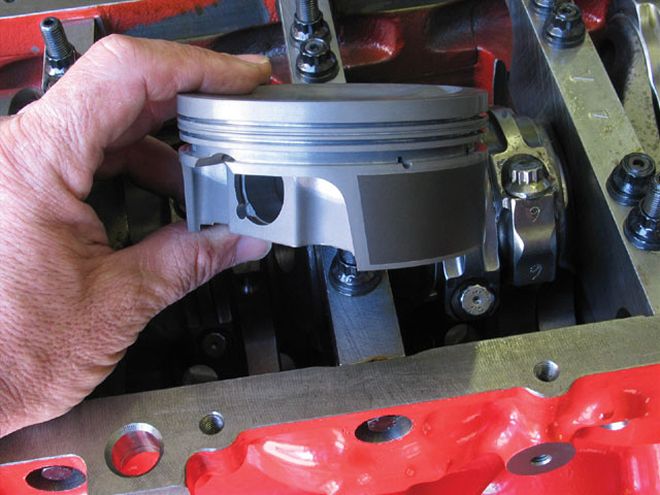 Among the wilder opportunities is the ERL Performance Superdeck I and II systems, which offer a combination of adding Darton ductile iron sleeves and an aluminum deck that bumps the deck height up to allow building something like an LS2 engine with a 4.20-inch bore and a 4.50-inch stroke displacing 499 ci. This particular photo is of an LS1 block.
Among the wilder opportunities is the ERL Performance Superdeck I and II systems, which offer a combination of adding Darton ductile iron sleeves and an aluminum deck that bumps the deck height up to allow building something like an LS2 engine with a 4.20-inch bore and a 4.50-inch stroke displacing 499 ci. This particular photo is of an LS1 block.
The ultimate aluminum Gen III/IV block has to be the fully machined billet block with water jackets available through Dart Machinery. Assuming you want to maintain the standard Gen III/IV 4.400 bore spacing, there are plenty of options available in terms of deck height, cylinder liner depth, and cam placement. Don't kid yourself-a Dart CNC billet block is mucho dinero, but it is also custom CNC-machined to your exact specs. Prices vary with the combination, so call Dart if this is a silver bullet with your name on it. You're guaranteed to be the only one in your neighborhood with one.
BORE AND STROKE/COMBINATIONS STOCK DISPLACEMENT CI LITERS RPO BORE STROKE BLOCK MATERIAL 293 4.8 LR4 3.{{{780}}} 3.268 iron 325 5.3 LM4 3.780 3.622 iron and aluminum 346 5.7 LS1/LS6 3.898 3.622 aluminum 364 6.0 LQ4/LQ9 4.000 3.622 aluminum 375 6.2 LS2/LS3 4.060 3.622 aluminum 427 7.0 LS7 4.125 4.000 aluminum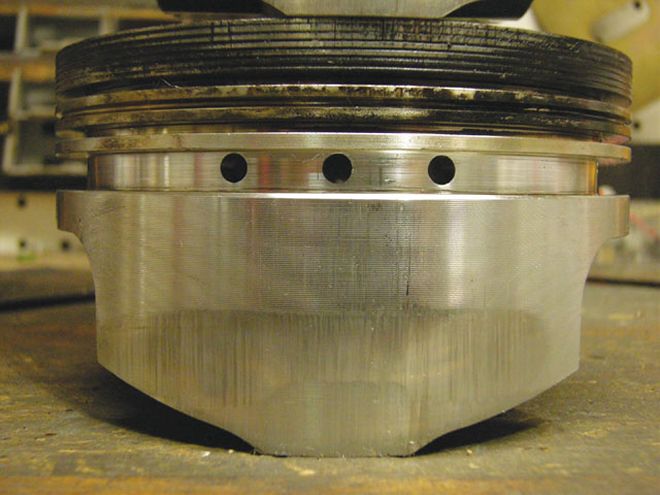 This is a piston used by Schwartz Extreme Performance with a 4.00-inch stroke crank on a production LS2 block. Schwartz believes the scoring is a result of the longer stroke exposing more of the piston skirt beyond the bottom of the bore.
STROKER DISPLACEMENT (CI) BORE STROKE 359 3.780 4.00 383 3.{{{900}}} 4.00 402 4.000 4.00 408 4.030 4.00 414 4.060 4.00 416 4.067 4.00 422 4.{{{100}}} 4.00 427 4.125 4.00 434 4.155 4.00 439 4.127 4.10 445 4.155 4.10 454 4.125 4.25 461 4.155 4.25 481 4.125 4.50
This is a piston used by Schwartz Extreme Performance with a 4.00-inch stroke crank on a production LS2 block. Schwartz believes the scoring is a result of the longer stroke exposing more of the piston skirt beyond the bottom of the bore.
STROKER DISPLACEMENT (CI) BORE STROKE 359 3.780 4.00 383 3.{{{900}}} 4.00 402 4.000 4.00 408 4.030 4.00 414 4.060 4.00 416 4.067 4.00 422 4.{{{100}}} 4.00 427 4.125 4.00 434 4.155 4.00 439 4.127 4.10 445 4.155 4.10 454 4.125 4.25 461 4.155 4.25 481 4.125 4.50
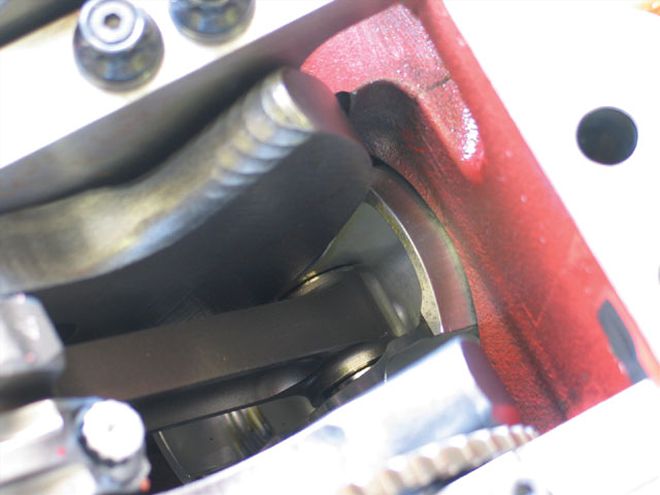 This is a shot of an LSX-block engine with a 4.00-inch stroke Callies crank, a 6.125-inch-long Oliver rod, and a JE piston. Note how the piston skirt extends only minimally past the bottom of the cylinder due to a shorter skirt piston.
DESCRIPTION PN SOURCE PRICE LQ9 iron 6.0L block 12572808 Scoggin-Dickey $701.85 LS2 aluminum 6.0L block 12568950 Scoggin-Dickey 999.99 LS3/L92 aluminum 6.2L block 12584727 Scoggin-Dickey 1,399.99 LS7 aluminum 7.0L block 17802854 Scoggin-Dickey 2,440.00 GMPP LSX iron block 19166454 Scoggin-Dickey 1,{{{928}}}.85 GM C5R race block, 4.125 bore 12480030 Scoggin-Dickey 6,679.95 World Warhawk block, 4.115 bore 086515 Jegs 4,399.99 Dart billet Gen III/IV block custom Dart Machinery Call for price
This is a shot of an LSX-block engine with a 4.00-inch stroke Callies crank, a 6.125-inch-long Oliver rod, and a JE piston. Note how the piston skirt extends only minimally past the bottom of the cylinder due to a shorter skirt piston.
DESCRIPTION PN SOURCE PRICE LQ9 iron 6.0L block 12572808 Scoggin-Dickey $701.85 LS2 aluminum 6.0L block 12568950 Scoggin-Dickey 999.99 LS3/L92 aluminum 6.2L block 12584727 Scoggin-Dickey 1,399.99 LS7 aluminum 7.0L block 17802854 Scoggin-Dickey 2,440.00 GMPP LSX iron block 19166454 Scoggin-Dickey 1,{{{928}}}.85 GM C5R race block, 4.125 bore 12480030 Scoggin-Dickey 6,679.95 World Warhawk block, 4.115 bore 086515 Jegs 4,399.99 Dart billet Gen III/IV block custom Dart Machinery Call for price
 This is a Mahle piston for a similar 4.00-inch stroke iron block 408ci engine we are currently building. Note the exceptionally short skirt that will only minimally extend past the bottom of the bore.
This is a Mahle piston for a similar 4.00-inch stroke iron block 408ci engine we are currently building. Note the exceptionally short skirt that will only minimally extend past the bottom of the bore.
Bore Length
One major concern with any stroker package on any engine has to be how far the piston extends out the bottom of the bore. We dug a little deeper and learned all production Gen III/IV blocks have a bore length of 5.500 inches with the exception of the LS7 engine, which has a cylinder bore length of around 5.900 inches. GM extended the length of the cylinder liners in the LS7 because of the longer 4.00-inch stroke using a shorter 6.067-inch-long rod compared with the normal production rod length of 6.098 inches. Most aftermarket connecting rods are longer, with the most popular being the 6.125-inch version. When increasing stroke, a longer rod not only improves the rod-length-to-stroke ratio (rod length divided by stroke) but also moves the piston farther up the bore, which reduces the amount of piston skirt that can extend out of the bottom. Even the GM LSX iron race block has an LS1 bore length.
Another variable here is the overall length of the piston skirt. In the photos supplied by Schwartz Extreme Performance, these pistons were used in a 402ci engine using a 4.00-inch-long stroke crank. The photo shows a skirt with scoring from 2,000 miles of street driving. While part of this may be attributed to a skirt that extends farther out of the bottom of the bore, scoring like this can also be a result of not adequately chamfering the bottom of the bores after honing. Schwartz says the bores on this engine were chamfered. Our local shop, Jim Grubbs Motorsports, also uses abrasive points from McMaster-Carr or Standard Abrasives to polish the chamfer. This prevents damage to the piston skirt.
We also spoke to Judson Massengill, owner of the School of Automotive Machinists in Houston. Massengill says he dislikes the 4.00-inch stroke crank packages for a street engine because they have difficulty with oil control. Apparently, the excessive piston rock at bottom dead center (BDC) causes oil control problems. Massengill prefers a 3.75-inch stroke crank, and he says while you might lose a little bit of torque compared with a 4.00-inch stroke displacement, the shorter stroke is cleaner and will make almost as much power, although slightly higher in the rpm range. Massengill did say that for a bracket engine or very limited street use engine, the 4.00-inch stroke systems do work. He just prefers not to run them in a street application. If the displacement is too tempting to avoid, Massengill suggests going to a Darton sleeve conversion on an aluminum block engine because the sleeves extend the length of the bore to accommodate the longer stroke. As you can imagine, this is not exactly a budget approach, but it does solve the piston skirt problem.
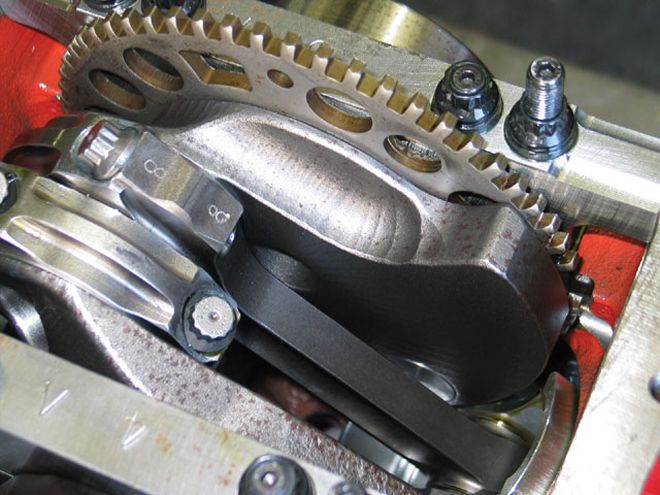 Most piston companies now add a relief to the sides of the piston to clear the reluctor wheel. This photo makes it difficult to see, but the reluctor wheel is very close to the piston at BDC.
Most piston companies now add a relief to the sides of the piston to clear the reluctor wheel. This photo makes it difficult to see, but the reluctor wheel is very close to the piston at BDC.
Companies such as GM Performance Parts dealer Scoggin-Dickey sell several short-block kits with a maximum stroke of 4.100. Scoggin-Dickey limits its stroker kits to a 4.100-inch stroke length to avoid extending the piston any farther out of the bore than possible. Many crank companies offer a 4.250-inch-long stroke (and as much as 4.500 for tall-deck blocks), but this is way too much stroke for any production block.
Stroker Packages
The best way to assemble a big-inch LS engine is to go with one of several crankshaft suppliers that offers stroker packages. This takes advantage of the company's experience with combining the proper piston and rod duo with the proper crankshaft counterweight. Oftentimes, car crafters will purchase a crank, rods, and pistons all from separate sources and then discover that very expensive balancing is required.
Popular crank companies such as Scat and Eagle offer complete crank, rod, piston, and ring combinations that are competitively priced and offer great reliability. The choices you need to be aware of include stroke length, H-beam or I-beam rods, rod length, compression ratio, and whether you want the assembly balanced. It's also important to know the reluctor wheel count when ordering your crank. Earlier Gen III engines used the 24-tooth wheel, while later Gen IV engines such as the LS2 and LS3 use the 58-tooth wheel. These need to match the crank sensor. Most of these kits offer quality pistons from companies such as Diamond, JE, Ross, or Wiseco. The chart at the bottom of this page lists three examples.
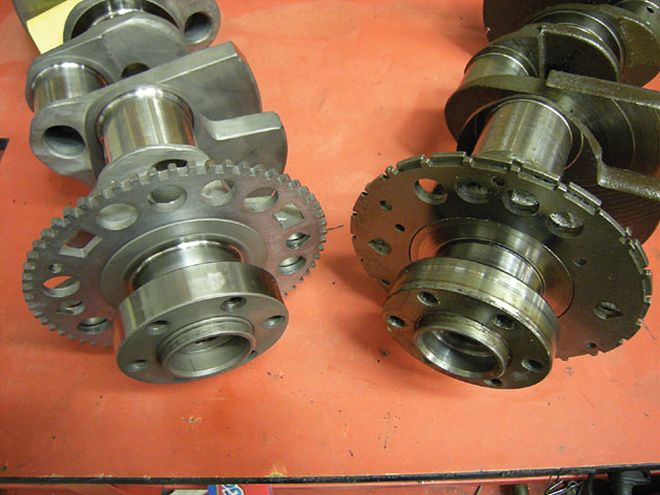 When ordering a stroker crankshaft, you should already know which engine the crank will be used in so you choose the correct tooth count for the reluctor wheel. On the left is a 58-tooth wheel with the 24-tooth wheel on the crank on the right.
RELUCTOR WHEEL CHART TOOTH VEHICLE YEAR COUNT {{{Camaro}}}/{{{Firebird}}} '99 to '02 24 {{{Corvette}}} '97 to '04 24 {{{GTO}}} '04 to '06 24 Corvette '05 to '08 58 truck '98 to '05 24 truck '06 to '08 58
DESCRIPTION PN SOURCE PRICE Scat 383ci, 3.75 stroke 1-91305BIE {{{Summit}}} Racing $1,103.95 Eagle 408ci, 4.00 stroke 12826 Summit Racing 2,619.95 Lunati 408ci, 4.00 stroke EA034-408 Summit Racing 3,955.99
When ordering a stroker crankshaft, you should already know which engine the crank will be used in so you choose the correct tooth count for the reluctor wheel. On the left is a 58-tooth wheel with the 24-tooth wheel on the crank on the right.
RELUCTOR WHEEL CHART TOOTH VEHICLE YEAR COUNT {{{Camaro}}}/{{{Firebird}}} '99 to '02 24 {{{Corvette}}} '97 to '04 24 {{{GTO}}} '04 to '06 24 Corvette '05 to '08 58 truck '98 to '05 24 truck '06 to '08 58
DESCRIPTION PN SOURCE PRICE Scat 383ci, 3.75 stroke 1-91305BIE {{{Summit}}} Racing $1,103.95 Eagle 408ci, 4.00 stroke 12826 Summit Racing 2,619.95 Lunati 408ci, 4.00 stroke EA034-408 Summit Racing 3,955.99
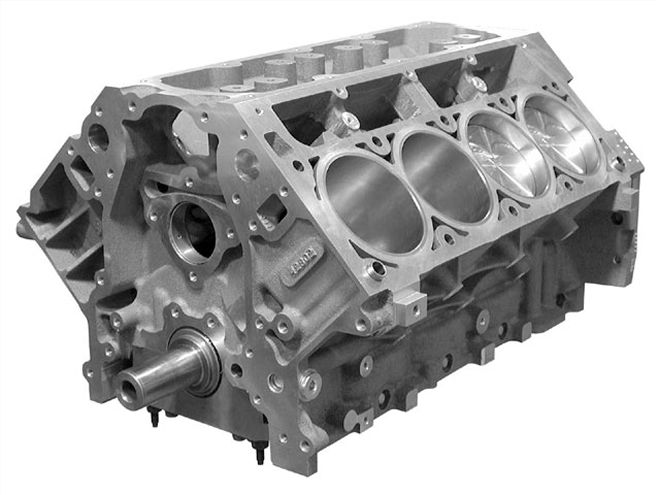 Most of the assembled short-blocks mentioned in this sidebar will come as you see this package, with the crank, rods, and pistons bolted together in a balanced assembly. You will have to supply the rest of the engine pieces.
Most of the assembled short-blocks mentioned in this sidebar will come as you see this package, with the crank, rods, and pistons bolted together in a balanced assembly. You will have to supply the rest of the engine pieces.
Assembled Short-Blocks
The only thing better than a stroker crank, rod, and piston package is having an assembled short-block delivered to your door. The beauty of this approach is you avoid all the hassles of assembling it. All you have to do is bolt on your cam and heads.
What looks like one of the most affordable short-block stroker assemblies on the planet is SLP's ZL402 package. Based on an iron LQ9 block, the SLP version uses a Callies 4340 steel crank with Manley H-beam rods and a set of SLP/Manley forged pistons with your choice of compression ratio and reluctor wheel count. The whole kit is balanced and assembled, but it is delivered as a bare short-block. That means you will need all the attendant small parts like an oil pump, an oil pan, plugs, and covers. GM Performance Parts has also introduced a complete assembly package that includes all the necessary parts to complete a bare block. We've included the part number, but at this writing, GMPP is not shipping these kits.
If an all-aluminum Gen IV engine has you captivated, SLP and Scoggin-Dickey Parts Center (SDPC) build 402ci or 416ci alloy engines. SDPC combines an L92 aluminum block with a 4.067-inch bore and a 4.00-inch stroke Eagle crank, along with Scat H-beam 6.125-inch rods to produce this lightweight package. If that seems tame, the company also offers El Toro Grande (The Big Bull), a 440ci LS7 block motor with a 4.100-inch stroke crank pushing 4.127-inch-wide pistons. The only thing bigger is World Products' Warhawk block; this aftermarket aluminum block can pump the bore up to a wide 4.125 inches. When you combine that with a 4.00-inch stroke crank, it equals a Rat-like 454 ci.
DESCRIPTION PN SOURCE PRICE 383ci LS1, 4.00 stroke LPELS1LS6SB383FT Lingenfelter $4,295.00 383ci LS1, 4.00 stroke SDLS6SB383FT Scoggin-Dickey 3,949.95 402ci LS2, 4.00 stroke SDLS2SB402FT Scoggin-Dickey 4,349.00 402ci iron 6.0L, 4.00 stroke 12400M24 SLP 3,821.35 402ci aluminum 6.0L, 4.00 stroke 12412M58 SLP 4,136.35 416ci L92, 4.00 stroke SDL92SB416D10 Scoggin-Dickey 4,689.00 440ci LS7, 4.100 stroke SDLS7SB440FT Scoggin-Dickey 6,249.00 427ci LS7, 4.00 stroke LPELS2SB427 Lingenfelter 6,395.00 454ci Warhawk 101264 World Products 8,397.99 GMPP block kit 19153789 Scoggin-Dickey n/a